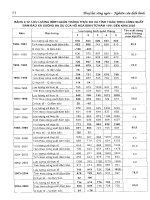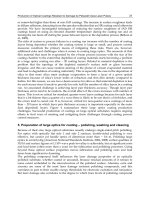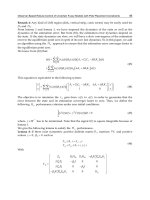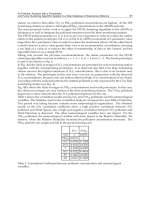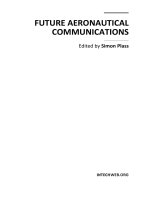Future Aeronautical Communications Part 3 pot
Bạn đang xem bản rút gọn của tài liệu. Xem và tải ngay bản đầy đủ của tài liệu tại đây (2.05 MB, 25 trang )
Future Aeronautical Communications
38
Wi-fi with the Gatelink solutions;
Cellular network directed toward aircraft such as the Aircell solution operating in
the US.
Wimax that is being introduced by a number of vendors
2. High speed geostationary satellites:
Ku-Band
Inmarsat new I-4 constellation of satellites
3. Low orbital altitude flying moving satellites
Iridium constellation of 66 satellites that can support data service up to 128Kbps
Iridium next generation satellite network, NEXT, planned for 2014/15
Each technology has its merits and limitations. As such it is expected that most will be in the
market for a number of years to come. What is less certain concerns the right commercial
approach to develop and gain market share. Regulatory aspects are also important, and they
will also affect the adoption of one technology over another for cockpit communication.
Today no standard approach has been adopted by airlines to implement new practices and
infrastructure to accommodate broadband aircraft communication capabilities. Essentially,
each implementation of supporting infrastructure has been unique. The only common IP
broadband technology installed in today’s major airframers New Generation Aircraft (NGA)
is the availability of a Terminal Wireless Lan Unit (TWLU) capable of wireless IEEE 802.11
connectivity from and to cockpit systems. Cellular connectivity is also widely used, but is
not generally connected to cockpit systems other than to the Quick Access Recorder (QAR).
EFBs are the main type of cockpit IT systems in use today. They require a level of resilience
above that needed by the non-critical applications, but the data exchanges, at least initially,
still can be limited to hubs and main stations; however the increasing complexity of EFB
applications will also make the IP wireless links (whether in the hubs in flight or at out
stations) and overall connectivity to airlines own networks much more critical for airlines
operations.
In addition to the normal use of ACARS for in-flight AOC and ATS communications, NGAs
will use more and more IP-wireless links not only to refresh the contents of their EFBs and
IFEs or to download massive amounts of flight and aircraft-related information, but also to
upload critical software parts and to access third parties’ networks while on the ground. The
availability and coverage of IP wireless links will shortly become paramount for airlines
operating these aircraft types. As of now most airlines have selected to use the wireless IP
broadband link at their hub only but the increase fleet size and requirement to cut costs and
increase productivity, is starting to trigger projects that aims to use this same capability at
out-stations. As such service providers will shortly be under considerable pressure to
provide IP-based services and coverage to facilitate the dispatch-ability of the aircrafts
regardless of where they fly.
The upcoming Boeing 787 will bring a marked departure from other NGA already
delivered. In fact current Boeing 777 and Airbus A380 operations do not imperatively
require IP broadband wireless connectivity. Data transfer can be deferred to hub-only
operations.
As mentioned before, the 787 fleets with its increased complex IT systems will bring more
opportunities for changes, since the volume, frequency, and criticality of exchanges of
operational information between the aircraft and ground systems is expected to be higher
than for older aircraft. It is expected that without the use of wireless links such as GateLink,
Handling Transition from Legacy Aircraft
Communication Services to New Ones – A Communication Service Provider's View
39
to transfer 787 data prior or after every flight that airlines may run into operational
inefficiencies. Consequently early 787 customers are expected to lead the way in their
adoption of new operational practices and systems surrounding aircraft connectivity, and
they form the primary initiators and requester of changes that may lead to a wider scale
industry adoption of standard solutions than what we have seen up to now. The same can
be said about the next up-coming new fleets such as the Airbus A350.
As an example to illustrate this need of increase data exchange for new aircraft is the Quick
Access recorder (QAR) data, known in the 787 as continuous parameter logging, or
Continuous Parameter Logging (CPL) which could produce up to 100 MB per flight. This
can take a considerable amount of time to download manually, and could be lost if the
transfer is not completed before the system memory is exhausted and overwrites the earliest
data. The same may apply to the engine health monitoring (EHM) data.
All other aircraft types (including 777s and A380s) can now be handled using legacy
services and practices, so there are presently limited incentive or urgency for undertaking
the significant investments to install or use new wireless technology even if the IT systems
installed in these aircraft allows such use.
In resume expectation are that early Boeing 787 operators may lead the way in their
adoption of new operational practices and systems surrounding aircraft connectivity.
3. Future communications systems and applications
The future SESAR ATM concept demands datalink services supporting features such as 4D
trajectory management, ASAS separation, automation, and SWIM. A reliable and efficient
communication infrastructure will have to serve all airspace users in all types of airspace
and phases of flight, providing the appropriate Quality of Service needed by the most
demanding applications. The mobile part of this infrastructure will be based on a multilink
approach, composed of three different subnetworks:
LDACS: A ground-based line of sight datalink as the main system in continental
airspace and supporting Air/Ground services and possibly Air/Air services, offering a
high Quality of Service which will be necessary in the high density areas; two systems
are under consideration (LDACS 1 and 2) with the objective to select one for
implementation. Both operate in the L-Band and are based on modern and efficient
protocols;
Satellite: A satellite based system providing the required capacity and Quality of
Service to serve oceanic airspace whilst complementing ground-based continental
datalink as a way of improving the total availability. The system is being defined in
close cooperation with the European Space Agency. The type of satellite constellation to
be used (dedicated or commercial) is still under consideration;
AeroMACS: A system dedicated to airport operations, based on mobile Wimax 802.16e,
providing a broadband capacity to support the exchanges of a significant amount of
information such as the uploading of databases or maps in the aircraft.
In addition, and to allow in the medium term interoperability with military operations, a
gateway is being defined to interconnect the ATM system and the military link 16 system.
Several research programmes have been launched to define, develop, and validate these
new solutions, and prepare the Aeronautical community to transition to these new access
networks. These activities are handled within SESAR programme. The SANDRA project
also takes into account the integration aspects of these new solutions, and the networking
environment (IPv6 will be introduced in place of IPv4).
Future Aeronautical Communications
40
Figure 5 gives an example of various networks and consequently operators that could be
involved in future ATS/AOC communications.
Fig. 5. Example of networks and actors that could be involved in future ATS/AOC
communications.
One major difference with IPv4/existing IP connectivity services is that mobility
management will probably be provided as a service. Mobile IP being part of the basic scope
of future ATS communications. Mobility Service Providers (MSPs) will thus be needed. We
can imagine of course having different MSPs between the APC domain and other domains.
The service provider on the APC side may even not be aero-specific. However, when we
compare these new schemes with the legacy ones (will be detailed in the following
chapters), the main actors types remain.
4. Analysis of service providers’ roles and business relationship
4.1 Now (ACARS, ATN, IP)
The ACARS business relationship can be modelled as shown in the diagram of Figure 6.
With a limited number of organizations dealing in this market, the model is very simple.
The actors identified are:
Users: Airline (Aircraft), ANSPs (Ground ATC End systems), 3
rd
parties for AOC/AAC
Global DSPs, providing ACARS service to aircraft and ground access to Aircraft using
ACARS service. This is globally limited to two organisations: ARINC and SITA. Global
DSP operate also their own VHF/VDL ‘almost’ worldwide network.
Local VHF and/or VDL mode 2 operators, providing VHF/VDL2 ACARS service to
aircraft, and ground access to global DSPs – a few ANSPs operate their own VDL/VHF
network – the trend is however to outsource the network service
Handling Transition from Legacy Aircraft
Communication Services to New Ones – A Communication Service Provider's View
41
Global
DSP
Global/Regional
DSP
Local
DSP
Local
DSP
Local
VHF/VDL
Operator
(ANSP)
Satellite
Operator
Satellite
Operator
Internetworking
agreement
Contractual
agreement
Contractual
agreement
DSP as
VHF/VDL
operator
Same entity
Service
agreement
ANSP
(Ground
connectivity)
Airline
(Aircraft operator)
Service
agreement
Fig. 6. Illustration of actors’ relationship for ACARS.
4.2 Focus on existing roles and actors in ATN/OSI
The ATN/VDL2 business relationship can also be simply modelled with a limited number
of organizations:
Users: Airline (Aircraft), ANSPs (Ground ATC End systems)
ATN operators, providing ATN networking service
VDL mode 2 operators, providing VDL2 access network and connectivity to Ground
ATN network
However, it has to be noted that ANSPs either purchase the VDL2 service to ‘global
operators’ such as SITA and ARINC, or operate the VDL2 service themselves and allow
global DSPs to manage the AOC traffic. Even if the overall trend is to outsource such
service to partners able to sustain the liability and SLA constraints of safety and dispatch
oriented services, these two models will likely be found for future communication means
(IP).
4.3 Focus on new roles with the introduction of new IT systems
The new business relationships become more complex in the new aircraft IT world with
many more players:
Users: Airline (Aircraft), ANSPs (Ground ATC End systems)
ATN operators, providing ATN networking service
VDL mode 2 operators, providing VDL2 access network and connectivity to Ground
ATN network
Global DSPs, providing ACARS service
Global IP communication service provider
Regional IP communication service provider
Future Aeronautical Communications
42
Global
ATN DSP
Global
ATN DSP
Local
DSP
Local
DSP
Local
VDL
Operator*
Internetworking
agreement
Contractual
agreement
Service
agreement
ANSP
ATN operator*
Same entity
Or service agreement
DSP =
VDL
operator
Same entity
Local
VDL
Operator*
Same entity
Or contractual agreement
ANSP
(Ground
connectivity)
Airline
(Aircraft operator)
Service
agreement
Fig. 7. Illustration of actors’ relationship for ATN/OSI over VDL mode 2.
Local IP communication service provider
Access network operator (e.g. Inmarsat for SwiftBroadband)
Solution integrator
Avionic vendor who now offer multiple IT solutions, communication services and back-
office solutions.
Airframers IT solutions
Airports networking services
Fig. 8. Identification of main actors for new IT systems operations.
Handling Transition from Legacy Aircraft
Communication Services to New Ones – A Communication Service Provider's View
43
If we take the example of SwiftBroadband, several major actors are involved
ASP (application service provider): provides the application using SBB Satcom services
SP (Service Provider): resells airtime and services to airlines; may activate SBB channel
if delegated from DP; may have own APN (Access Point Name: network node on
ground for traffic routing), if agreed with DP
DP (Distribution Partner): SBB channel activation (one SIM card per channel); resells
airtime to Service Provider; may directly retail airtime to airline (e.g. OnAir) - DP is
linked to SIM card, thus potentially one DP per SBB channel
Satellite / Swiftbroadband service Operator (Inmarsat)
The actors listed above, specific to SwiftBroadband are Inmarsat and the DP. The other ones
can easily perform horizontal integration (with other access networks). A given partnet can
perform vertical integration (act as a DP and ASP/SP). All combinations are possible,
several DPs per aircraft, several SPs per SIMCard, etc. However, it is of course strongly
advised, in order to make the system manageable, to minimize the number of actors and
rely on key players.
SP
Airline
DP
Service
agreement
Contractual
agreement
ASP
Contractual
agreement
ASP
SP
Service
agreement
Inmarsat
Contractual
agreement
Fig. 9. Actors and relationship for SwiftBroadband
Future Aeronautical Communications
44
4.4 What could be the winning combinations after cards have been shuffled again?
4.4.1 Key technologies and integration on aircraft
Some of the key enabler to an eventual global successful aircraft connectivity solution, is the
availability of adequate aircraft-ground connectivity technologies, at the right performances,
with worldwide availability, at the right price and ability to integrate these technologies in a
large retro-fit program, at minimum cost and reduced aircraft down time. Security of the
solution is also imperative.
Such solutions must then:
Provide sufficient coverage/availability (regional, airports, etc.)
Be implementable at minimum cost on aircraft or be provided as part of wider system
A number of proprietary solutions such as Aircell, Teledyne WGL/QAR exist and reached
an interesting level of success.
Adding new technology, new providers and new application creates an environment that is
becoming exponentially complex. At the end, airlines being successful will definitively need
to be able to make the right choices, reduce their risks and be carefully to limit their
investment to solutions that will last. One of the factors that enables meeting these objectives
and constrains is to share those risks and investments with industry partners. Another key
element to choose adequate partners is the ubiquity of the solution they propose. As airlines
fly everywhere, the solution chosen must be available globally. Solutions that remain only
available in certain geographic location may certainly last in a specific market, but have not
the potentials to become industry standards.
Regulatory aspects
A number of regulatory requirements and actors come into action when we talk about
aircraft communications.
Operating an access network generally imposes the use of radio licenses
Dealing with ATS communications implies to interact with national ANSPs as
customers or as providers/partners
And many others
The ability to deal with such entities is a prerequisite to global service provisioning. Of
course, but this is a special item, an aircraft embedded system needs to be certified at
appropriate assurance level
Vertical and Horizontal integration
It is interesting to focus on the positioning of the success players in datalink history and see
how things are evolving. Horizontal integration at access network and network level is
compulsory to provide consistent services, and add value to the fact of integrating multiple
dissimilar access networks (with their incumbent complexity due to the multiplicity of
operators).
This is what happened in ACARS and ATN. Traditional DSPs started developing with
vertically integrated solution (VHF – ACARS – some application services) to horizontal
integration to make the services available worldwide (VHF operated by DSP and other
access network services outsourced (Inmarsat). Traditional DSPs have positioned
themselves more in the Cockpit communications domains than on cabin domain.
Another important factor here is the existence of historic operators/compulsory operators
that are imposed by local regulations. The ability to deal with such entities is a prerequisite
to global service provisioning.
Handling Transition from Legacy Aircraft
Communication Services to New Ones – A Communication Service Provider's View
45
We could define vertical integration by the fact of acquiring the ability to control parts or all
the actors/functions needed to provide an overall service, i.e. providing at the same time
different levels of service (access, network, application, etc.), while horizontal integration
could be defined as the fact of acquiring the ability to widen geographically or in terms of
market target (e.g. cabin versus cockpit) a given service.
Figure 10 illustrates this concept. It is interesting to see that, depending on the market
segment (ATS/AOC legacy,…), and the service level, the position of existing bridges
(similar products that can satisfy upper services) can vary. For example, it is obvious to
notice that ATS/AOC and EFB will likely call similar skills and services (IT integration, data
production and publishing), while communication means between EFB and cabin could be
shared (e.g. SBB,…).
e.g.
ACARS
Wx request
e.g. ATS
connectivity
Legacy
Access network
services:
e.g. VHF,…
Added
value
Portfolio range
e.g.
EFB content
distribution…
e.g. EFB
connectivity
e.g. Gatelink,
SBB,…
e.g.
Pax connectivity,
IFE content
distribution
e.g. roaming
e.g.
SBB, KuBand…
ATS/AOC legacy EFB Cabin/Pax
e.g.
SWIM data
services
e.g.
SWIM
connectivity
New
Access network
services:
e.g. AeroMacs,
LDACS
,…
ATS/AOC future
Fig. 10. Illustration of Vertical and horizontal integration.
Future Aeronautical Communications
46
Current and future NGA operator’s views
The recent survey with NGA operator mentioned earlier includes many indications that
confirms and support many of the information given in this chapter. Here is a small
overview of what some of the key players in airline operation are mutually saying about
using new IT technologies in aircraft operation:
- Understanding the complexity and inter-relationship that will shape the future of
aircraft operation result in a long learning curve.
- The requirement for cross organisational collaboration is viewed as an essential element
for a successful program to implement new technologies for aircraft operation.
- Many delays are caused by the needs for common understanding and alignment of the
multiple parties involved, including regulatory authority, airframers and standard
bodies.
- Obsolescence of chosen technology in contrast to the life time of fleet-wide
implementations is a major concern an often a road block to making technological
choices.
- There is a tendency to make incremental steps forward as the solutions and industry
vision evolves.
- The search for real business value leading to a successful business case is a difficult task
in the current context.
5. Conclusion
Airlines expect to be able to meet their short and long term business objectives using the
new IT technology available in the aircraft cockpit. No specific solution, IP broadband
communication method or technology as yet rises to become the industry standard
necessary to limit the risk associated with large deployment project. This is the case for both
airlines and service providers. Legacy system and communication technology installed in
today’s aircraft will remain pertinent for the foreseen future and need to be integrated in the
offered IT solutions. The complexity associated with the installation and operation of new IT
systems is continuously rising. Absolute confidence in watertight security of the new
systems and communication links must be achieved.
As the technologies used in aviation applications move from purpose-built to generic, the
entry barriers for new entrants have been considerably lowered. Consequently the
complexity and diversity of the solutions and required inter-relationship of the industry
players is considerably augmented. Providers have to be carefully chosen by airlines based
on their offer of valuable and compelling service that can assist them to make the most
efficient use of their modern aircraft without compromising their operational flexibility or
security. Solutions that can be built to take into consideration the various technology
choices, requirements for global availability, the typical aircrafts projects life-time,
integration with legacy systems and needs for common approaches will certainly have a
better chance to be successful in the long term.
As we have seen above, from the customer’s prospective, dealing with major partners
providing horizontally integrated solutions, especially at access network level, will likely
be the way to go, providing that the investment stays reasonable and offers an interesting
return on investment scheme. Of course, horizontal integration should target the pertinent
access network technologies (efficient, reasonable cost) that can be deployed on aircraft at
Handling Transition from Legacy Aircraft
Communication Services to New Ones – A Communication Service Provider's View
47
reasonable cost and cycle. Each customer’s case is specific, so it is of course too simplistic to
summarize it this way, but this trend might well prove to be true.
It will be several years before new cockpit technology deliver on its expected benefits to
reduce overall fleets operational cost and improve productivity, but we are clearly heading
in that direction.
Possible customers’ perspective
We do not take much risk if we say that customers seek
Low cost
SLA/SLO and adequate performances
Globally available service – at least on strategic routes or locations
If possible, end to end managed service
And now, proper integration in their operations process (integration in their IT
environment or hosted IT environment)
For some specific discriminating services towards their competition, some airlines may be
willing to invest to offer unique services to attract new passengers, for example in the
domain of aircraft passenger services.
We could conclude from this chapter that, in order to make future connectivity services a
success, the airlines will seek for service providers
Horizontally integrated
Multiple radio access networks and ground networks
Vertically integrated
Application services
Up to the IT infrastructures
And of course there is a STRONG
Need for competition
Standardization
Multiple players
This is a general conclusion, and, as said before, airlines needs need to be studied on a case
by case basis, but we tried here to give general trends that will hopefully help the reader
have a wider view of the situation.
6. Appendix – case study: AeroMACS
This section aims at introducing the various possible actors in AeroMACS connectivity
service and identifies their possible contractual relationship.
The following applications have been identified as target by RTCA SC223 and/or Eurocae
WG82:
Fixed users (RTCA only)
Airport LAN extensions
o Unique equipment (terminals, cameras,…)
o Or Multiple equipment behind Mobile System (MS)
ANSP managed equipment
o Integration of RNAV systems, radar… into ANSP network
Mobile users
Future Aeronautical Communications
48
Airport trucks (catering, maintenance, fuel….)
Luggage terminals,….
Single users (= user terminal) belonging to different networks or LANs (!) (airport,
MRO, catering, fuel……)
Support for VoIP (RTCA only)
Aircraft
ATC, AOC,direct operational impact / safety impact
AAC applications no direct operational impact
End to end (to airline and ANSPs) communication but also potentially local
communications (cache servers)
Need to segregate on aircraft at minimum between various users domain (avionics
(ATC, AOC) – IT domain (AOC, AAC) – Pax domain)
6.1 Actors and possible business / contractual relationship
WiMax forum (WMF) Network architecture group has identified the following typical
business relationship for WiMax as shown in Figure 11.
Fig. 11. WiMax forum identified actors and relationship.
Handling Transition from Legacy Aircraft
Communication Services to New Ones – A Communication Service Provider's View
49
In the aeronautical environment, the following actors have been identified:
NAP
Specialized Airport operator
Traditional DSP (ARINC, SITA, AVICOM,….)
ANSP
V-NSP
Traditional DSP (ARINC, SITA, AVICOM,….)
ANSP
Local operator
Specialized Airport operator
H-NSP
Traditional DSP (ARINC, SITA, AVICOM,….)
Others
In Figure 12, the reference contractual/business relation ship between various actors in the
aeronautical environment could be as illustrated.
H-NSP
(e.g. SITA)
NAP (region#2)
airport
ASN
NAP (Region#1)
airport
ASN
airport
ASN
NAP = H-NSP
airport
ASN
airport
ASN
Visited
NSP
(region#2)
airport
ASN
Airline
Contractual agreement
Contractual
agreement
Roaming
agreement
Service
Level
Agreement
Between wimax
operator and
Home NSP
Same company
Fig. 12. Actors and possible relationship for Aeromacs.
Future Aeronautical Communications
50
6.2 Network deployment use cases
The following deployment use cases have been identified by WMF (reference).:
A.3.1 NAP Sharing by Multiple NSPs
A.3.2 Single NSP Providing Access Through Multiple NAPs
A.3.3 Greenfield WiMAX NAP+NSP
A.3.4 Greenfield WiMAX NAP+NSP with NAP Sharing
A.3.5 Greenfield WiMAX NAP+NSP Providing Roaming
A.3.6 Visited NSP Providing WiMAX Services
A.3.7 Home NSP Providing WiMAX Services
The deployment use cases identified above are instantiated for aeronautical environment as
follows – please note that multiple use cases will be supported at the same time. Especially,
an aircraft will need to be able to interact with various use cases, depending of its location at
time T.
Open points to be discussed:
Multiple NAPs will be available in a given airport and one used at a given time by an
aircraft
An aircraft may contract several H-NSPs and selection will be done in real time.
Need for NAPs to advertise supported NSPs (H-NSP??) and the aircraft will then select
the preferred H-NSP
6.3 RF deployment use cases
Several radio / NAP deployments are possible:
1. Single NAP – single radio channel
Use service flows / QoS to distinguish between application types (aircraft)
All NSPs advertise on this channel
2. Single NAP – Multiple radio channels
1 channel for aircraft communications
All NSPs advertise on this channel
1 or several channel for fixed and mobile users
3. Single NAP – Multiple radio channels
1 channel for safety communications (ATC/AOC) for aircraft and mobiles
1 channel for non safety (AAC), including mobiles
1 channel for fixed users (RTCA use case)
Implies 2 radios on aircraft. This solution is probably not adequate due to aircraft
systems complexity
4. Multiple NAPs – Multiple radio channels (NAP+NSP solution)
1 several channels for fixed and mobile users
Various constraints need to be taken into account to determine the appropriate solution(s):
Channels allocation scheme selected by various states/countries
Limit configuration changes on aircraft side
Segregation between non safety/dispatch impacting traffic and non safety / non
dispatch impacting traffic
An aircraft will need to interoperate with any AeroMACS infrastructure, while ground
mobiles and fixed users may be tailored to specific ground infrastructures
Fixed infrastructures support safety traffic may need to be severely segregated from
mobile infrastructures
Handling Transition from Legacy Aircraft
Communication Services to New Ones – A Communication Service Provider's View
51
Table 2. Network deployment use cases (part I).
Future Aeronautical Communications
52
Table 2. Network deployment use cases (part II).
Handling Transition from Legacy Aircraft
Communication Services to New Ones – A Communication Service Provider's View
53
Table 2. Network deployment use cases (part III).
Future Aeronautical Communications
54
6.4 Conclusion on the AeroMACS case study
We have seen that many deployment configurations were possible for AeroMACS
connectivity service. The deployment / contractual relationships and associated actors are
still under discussion in various standardization bodies. However, we can see that the
number of actors and the variety of situations will likely drive the need, as seen in
legacy/emerging connectivity services, for overall mobility service providers, aka Global
DSPs, to hide the complexity of the connectivity service schemes to be establish to provide a
global, seamless, simple and efficient service to the various service customers.
7. Acknowledgement
The research leading to these results has been partially funded by the European
Community's Seventh Framework Programme (FP7/2007-2013) under Grant Agreement
n° 233679. The SANDRA project is a Large Scale Integrating Project for the FP7 Topic
AAT.2008.4.4.2 (Integrated approach to network centric aircraft communications
for global aircraft operations). The project has 31 partners and started on 1st October
2009.
8. References
WiMax Forum Network Architecture (Stage 2: Architecture Tenets, Reference Model and
Reference Points) [Part 3 – Informative Annex] Release 1.0 Version 4
ICAO ANNEX 10 to the Convention on International Civil Aviation Aeronautical
Telecommunications (Volumes I, II, III, IV and V)
SITA AIRCOM new generation services Positioning Paper – White Paper – 2010
SITA - The “Digital aircraft” –heralding a new generation of aircraft operations – New
Frontiers paper – 2010
WiMax Forum Network Architecture (Stage 2: Architecture Tenets, Reference Model and
Reference Points) [Part 0] Release 10 Version 4
(WMF-T32-001-R010v04_Network-Stage2-Part0_0)
WiMax Forum Network Architecture (Stage 2: Architecture Tenets, Reference Model and
Reference Points) [Part 1] Release 10 Version 4
WMF-T32-002-R010v04_Network-Stage2-Part1_2_0
WiMax Forum Network Architecture (Stage 2: Architecture Tenets, Reference Model and
Reference Points) [Part 2] Release 10 Version 4
WMF-T32-003-R010v04_Network-Stage2-Part2
Part 2
Future Aeronautical Network Aspects
3
SOA-Based Aeronautical Service Integration
Yifang Liu
1
, Yongqiang Cheng
1
, Yim Fun Hu
1
,
Prashant Pillai
1
and Vincenzo Esposito
2
1
School of Engineering, Design and Technology, University of Bradford
2
SELEX Sistemi Integrati S.p.A.
1
United Kingdom
2
Italy
1. Introduction
Over the past two decades, the air transport industry has experienced continuous growth.
The demand for passenger air traffic is forecast to double the current level by about 2025
(European Organisation for the Safety of Air Navigation [EUROCONTROL], 2006). Small-
to-medium sized low cost airlines in Europe such as EasyJet and Ryanair have observed a
considerable percentage of passenger increase between 2008 and 2009 due to the growth in
the number of regional airports and more choices offered on international destinations
(EasyJet & Ryanair, 2009). To accommodate such growth and changes in new flight patterns
and strategies, it is of paramount importance to ensure air transport communication systems
around the globe be integrated to enable efficient air-to-ground and ground-to-ground
communications for global air traffic management and coordination.
Traditional approaches for aeronautical system integration in the past impose a high level of
system dependencies; a fixed connection is required to be set up every time a new
application is added. Therefore, aviation companies are facing continuous investment
increase every time a new connection is established. This situation discourages enterprises
from fulfilling grater business values by adding interior constraints; it restricts the number
of applications and services that can be integrated into the existing IT infrastructure. In
safety-critical systems in the aeronautical context, overloaded complex system structure will
increase the chances of operational failures and jeopardise passenger safety. Therefore, it is
important to devise a suitable architecture which minimises system dependencies and
allows new applications to be integrated easily with the lowest IT maintenance budget. A
layer-extensible blueprint in a Service-Oriented Architecture (SOA) is considered as a
solution in this case for the integration of future aeronautical communication systems. The
proposed framework should allow consistent data capturing and sharing among all end
users who are involved in the global aircraft operations in the 2020 timeframe and beyond.
In recent years, the SESAR SWIM (Single European Sky Air Traffic Management Research
System Wide Information Management) concept has reflected the emerging needs and
willingness of Air Traffic Management (ATM) organisations in transforming proprietary
ATM systems into a standardised and interoperable information pool in the pan-European
aeronautical network. As the challenge still exists where the ATM stakeholders today do not
want to deal with the complexity of the lower communication layers, SOA is considered as
Future Aeronautical Communications
58
one of the most effective emerging technologies to provide a scalable, flexible and
interoperable system framework, according the adoption of the SOA paradigm in the global
SWIM studies (Houdebert & Ayral, 2010; Luckenbaugh et al., 2007). However, SWIM
focuses on ground-to-ground aeronautical services.
In extending the SWIM ideology to an airborne context, the EU FP7 project SANDRA
(Seamless Aeronautical Networking through integration of Data-Links, Radios and
Antennas) continues with the SOA notion in air-to-ground information exchange, service
composition and integration to provide a complete and coherent set of communication
services for Next Generation global Air Traffic Management.
Building on the investigation and analysis of the existing industrial programmes targeting
aeronautical service integration, this chapter provides an introduction of the SOA-based
future avionic systems. Section two outlines the middleware concept, the service-oriented
architecture, its implementation technologies and the use of SOA design solutions forming
an integrated ATM framework. Section three summarises the SOA-based future
aeronautical communication referring to the SESAR and FAA (Federal Aviation
Administration) SWIM approaches for information fusion and dissemination for ground-to-
ground service integration. The SWIM ATM added-value services, data access services and
technical services defined in Section three are used as a baseline for the definition of the
SANDRA Airborne Middleware (SAM) through the utilisation of a set of airborne/ground
data domain objects, as described in Section four. Finally, analysis of the service
improvement methods and the technology options for future ATM system realisation is
addressed at the end of this chapter.
2. SOA in aeronautical communication
SOA is an emerging middleware approach for linking various legacy systems into a
standard platform to achieve a highly interoperable and collaborative communication
infrastructure. It permits the separation of legacy system service interfaces from the
underlying implementation, thus to reduce technology-dependent attributes of the system.
SOA promotes service reusability and interoperability through a set of standardised data
schemas used in the discovery and self-description of each course-grained, composed and
loosely-coupled service.
The SOA capabilities are seen as an enabler for the realisation of the EUROCONTROL
SESAR concept (EUROCONTROL, 2008), which explicitly states the focus on the global
ATM interoperability with regard to the semantics of the data exchanged, the protocols and
the overall quality of dialogue in terms of Communication, Navigation and Surveillance
(CNS). According to the ICAO 2010 operational opportunity report (International Civil
Aviation Organisation [ICAO], 2010), the European ATM Master Plan defines the “path”
towards achieving performance goals by adopting the service-oriented architecture as
agreed at the European Union ministerial level. The main targets are to:
Enable a 10% reduction in CO2 emissions per flight
Reduce ATM costs by 50%
Enable a 3 times increase in capacity
Improve safety by a factor of 10
Supported by state-of-the-art and innovative technologies designed to eliminate
fragmentation in the future European ATM system, SOA-based middleware reflects the
operational, technological and regulatory requirements of the future ATM infrastructure
while serving for the improvement of system efficiency and interoperability.
SOA-Based Aeronautical Service Integration
59
2.1 Middleware and service-oriented architecture
2.1.1 Definition of middleware
The term middleware was first introduced in 1968 and had only gained its popularity until
it was formally used as an integration platform to connect different systems and
applications since the 1980s. The role of middleware varies in different domains. In the
scope of enterprise applications integration, middleware is called plumbing because it
connects two applications and passes data in between (Simon, 2003). For purpose such as
data integration of heterogeneous networks across different geographical locations,
especially in the Air Traffic Management context, middleware is a distributed software layer
that sits above the operating system and below the application layer and abstract the
heterogeneity of the underlying environment. Middleware provides an integrated
distributed environment whose objective is to simplify the task of programming and
managing distributed applications (Campbell et al., 1999).
The common types of middleware are Message-Oriented Middleware (MOM), adaptive and
reflective middleware and transaction middleware. Middleware can be grouped according
to different technologies, such as grid middleware, peer-to-peer middleware and real-time
middleware concerning the Quality of Service, security, performance, Model-Driven
Architecture, Service-Oriented Architecture and more (Mahmoud, 2004).
In aviation, the shift from proprietary air traffic control systems into a standardised and
interoperable platform embracing the middleware approach facilitates the communication
and integration of a wide range of ground-based and air-to-ground system applications
operating across the networks. The middleware acts as an intermediary enabling direct
communication with the legacy technology interfaces, to minimise system dependency.
2.1.2 Definition of service-oriented architecture
As an embodiment of the middleware concept, SOA is a paradigm for the integration of
various applications running on heterogeneous platforms using common standards. It is
designed to consolidate the system capabilities for the organisation and utilisation of data
distribution managed by different ownership domains. The term “service” can be defined as
a single or multiple operational functions offered by a software system for the fulfilment of
business objectives, for example, flight plan filing, aircraft tracking, controller-pilot
communication and passenger logistics management. The specification of services may be
modified as the business objectives and operations change.
There are eight design principles that affect the design of services and SOA-based system
integration (Erl, 2009):
Standard Service Contract – Services within the same service inventory should have
the same contract design standards.
Service Loose Coupling – Service contracts ensure the service consumers are
decoupled from their surrounding environment.
Service Abstraction – Information contained in the service contracts are limited to what
is published.
Service Reusability – Services contain and express agnostic logic and can be reused as
enterprise resources.
Service Autonomy – Services exercise a high level of control over their underlying run-
time execution environment.
Service Statelessness – Minimised resource consumption by deferring the management
of state information when necessary.
Future Aeronautical Communications
60
Service Discoverability – Services described with metadata can be effectively
discovered and interpreted.
Service Composability – Services are effective composition participants.
The SOA concept as a recommendation for system integration is an emerging approach in
the ATM development programmes in Europe and North America. It offers a uniform
platform, which supports the registration, discovery and administration of individual
business process with use capabilities to produce desired effects consistent with measurable
preconditions and expectations in a short timeframe.
Rooted in the Business Process Management (BPM) notion, SOA is a holistic mechanism for
the alignment and harmonisation of an enterprise and its IT development as:
SOA encompasses the tools and methodologies for capturing business design, and uses
that design information to help improve the business.
SOA covers the programming model, tools, and techniques for implementing the
business design in information systems.
SOA contains the middleware infrastructure for hosting that implementation.
SOA encompasses the management of that implementation to ensure availability to the
business and efficient use of resources in the execution of that implementation.
SOA encompasses the establishment of who has authority and the processes that are
used to control changes in the business design and its implementation.
The SOA principles and standards highlight the significance of loosely coupled and reusable
services in the software architecture perspective. Services are independent and are accessed
via standardised interfaces as a frontend of the massive network resources. The advantage
lies at the transparent communication SOA offers to end-systems (technology-agnostic), and
hence, to effectively demonstrate the application of data-centric information sharing. The
SWIM infrastructure provides the basis for information exchange between systems based on
the principles of SOA.
2.2 SOA implementation technologies
The definition of SOA emphasises that the concept of service-orientation is a paradigm
solely. SOA is remarkable for its flexibility allowing many types of system interactions to be
performed based on a series of pre-defined architectural patterns. From the functional point
of view, classification of business process and service interaction modelling are two
dominant motives at system planning and design stage. Afterwards, the realisation of
software services supporting these interactions requires the state-of-the-art technologies to
be defined. Technology-independence is one of the most important criterions in terms of
technology evaluation.
The paragraphs below provide a general overview on common technologies for the
implementation of a service-oriented architecture of which are used in aeronautical
communication.
2.2.1 BPM, BPMN and BPEL
In the past 30 years, the growing concept of Business Process Management (BPM) has
shifted from the use of static business process flowcharts in unchanging organisations to
dynamic corporate processes which can be accessed by collaborating partners in a more
flexible and efficient way. A business process can be summarised as a collection of
structured activity to produce a specific business service or product. BPM introduces
SOA-Based Aeronautical Service Integration
61
sophisticated software and best practices targeting the modelling, simulation, automation
and management of cooperative operations with dynamic business priorities.
Business Process Modelling Notation (BPMN) is a visual language with graphical
notations for the modelling of business processes. It presents the business activities, tasks
and their relations in a business process diagram (Juric et al, 2008). BPMN can be used in
collaborative processes and internal business processes. The BPMN models in future
aeronautical communication should appear as a mixture of both intra-business and inter-
business flows reflecting the concept of Collaborative Decision Making (CDM).
To implement the modelled business interactions, Business Process Execution Language
(BPEL) enables the service orchestration for composed service and business processes
reinforcing service reusability and loose coupling. BPEL conducts the orchestration of
services. It is mapped from the BPMN diagram for service execution, and thus allowing
integrated monitoring functions to be applied. The predominant standard for BPEL is the
Business Process Execution Language for Web Services (BPEL4WS v1.1) in 2003 (Andrews et
al, 2003), defined in the human-readable Extensive Mark-up Language.
Based on the BPM-related concepts, the SESAR SWIM Program has addressed the need to
derive a common view on the ATM business processes for accessing SWIM ATM Data and
ATM functionalities. The development of a formal business process model has been
recommended and it is essential to follow standard IT industry practices through the use of
enterprise architecture modelling techniques.
2.2.2 Web services
The Web Service infrastructure is one of the most common approaches for the realisation of
SOA. It is recognised as a predominant technology framework in the avionic industry for
the realisation of the SWIM infrastructure. The World Wide Web Consortium (W3C) defines
Web services as a standard software system for interoperating different software
applications running on a variety of platforms and/or frameworks (W3C, 2004). A Web
service supports interoperable machine-to-machine interaction over a network based on the
Web service stack illustrated in Fig. 1.
Fig. 1. Web Service Stack.


